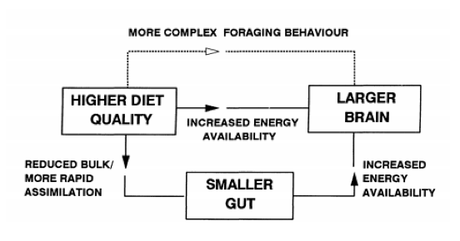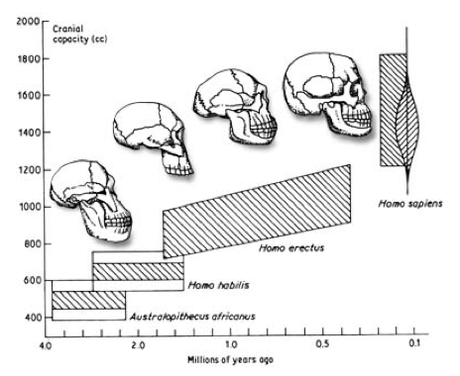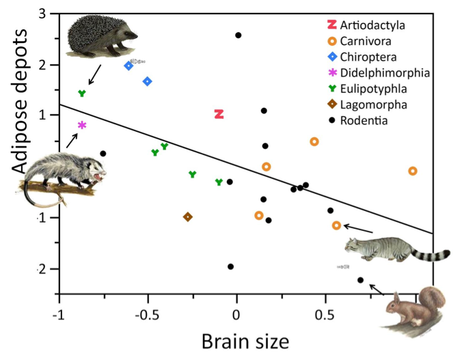This post first appeared on The Advanced Apes earlier today
As great as our big brains are they also have a significant downside: they’re expensive. Despite the fact they only account for 2% of your body weight they require 20% of your calories to keep them going. That’s about as many calories as you get from a Big Mac, all spent on just keeping your brain ticking over. Despite all the benefits they give us we simply wouldn’t have been able to evolve them unless we could somehow fuel them.
Surprisingly, even though we have to fuel a massive thinking organ we don’t use more energy than a chimp; whose piddly little brain is only ¼ the size of ours (which will make it more embarrassing when they take over the world). This prompted Aiello and Wheeler (1995) to suggest that other parts of our body had shrunk to lessen their energy requirements, creating a surplus which could be spent on the brain.
They figured that it was the gut which had made this noble sacrifice. Pound for pound the digestive system is as energetically expensive as the brain (Aiello and Wheeler, 1995), so it seems likely that if an animal could they would reduce the size of it. Evolution is a balancing act, trying to make the best animal as quickly and as energetically cheaply as possible; so if an expensive organ can be made smaller it will be. This need not have happened specifically to enable large brains, natural selection could just be making our ancestors more efficient, which had the happy coincidence of creating an energy surplus.

Infographic explaining the expensive tissue hypothesis
Indeed, we do have smaller guts than an animal of our body size should have (Aiello and Wheeler, 1995), but why could our ancestors afford to shrink their gut? After all, being able to digest food is rather important to survival. It would seem that around 3 million years ago our family had started spending more time on the ground, where they started to venture into open grassland. There they would find large prey animals, which are an abundant source of energy rich meat.
Whilst it is more likely they were scavenging this meat than actually hunting the animals themselves, they were nevertheless managing to eat meat by ~2.5 million years ago (de Heinzelin et al., 1999). This high calorie food is much easier to digest than plants, meaning that we could get by with a smaller (and energetically cheaper) gut. It’s telling that only 200,000 years after the first evidence of meat consumption appears our brains had doubled in size (Boyd and Silk, 2009).
So we eat meat, meaning we can get by with a smaller gut. This leads to a surplus of energy which can be spent on developing a large brain, because large brains are great. This improves our technology, allowing us to process food with tools and fire. This effectively “pre-digests” the food, allowing our guts to shrink even further. Around 1.7 million years ago, when the first evidence of fire appears, brain size increases from 600cc to 850cc. 200,000 years later they’d increased to 1150cc, which falls within the range of modern humans (Boyd and Silk, 2009).

Increase in brain size over the course of human evolution. Note the leap with Homo habilis, who started eating meat and Homo erectus, who started using fire
So it would seem that the expensive tissue hypothesis is a good explanation for what enabled the development of large brains. Granted it doesn’t explain why they then got bigger (we have other hypotheses for that) but it does “set the stage” for the growth. This was thinking for over a decade until in 2011 a team from the University of Zurich discovered what appeared to be a fatal flaw in the expensive tissue hypothesis.
Many ideas about human evolution use evidence from other species to support their claims. If something prompts the evolution of a trait in another lineage then it may have prompted the development of that trait in ours as well. Aiello and Wheeler – the inventors of the ETH – believed the same would be true for the expensive tissue hypothesis and that we would find that many other species had reduced gut size in favour of large brains (and vice versa, because cows are dim). However, Navarrete et al. (2011) examined over 100 species of mammal in an effort to find this correlation but failed (although they did find a correlation between brain size and quantity of fat deposits, with big brained animals having less fat).
Overturning a well-accepted hypothesis is something every scientist dreams of doing, and these researchers proudly wrote that “brain size is not negatively correlated with the mass of the digestive tract or any other expensive organ, thus refuting the expensive-tissue hypothesis.” Aiello herself appears to have accepted this conclusion, although claims the expensive tissue hypothesis is still valid. It’s just that fat that decreased over time and that enabled brain growth (Aiello and Anton, 2012).

The correlation between brain size and fat (adipose) deposit size, showing how bigger brains are associated with less adipose
Under this new model an animal has two choices to deal with harsh environments. They can either build up fat reserves or evolve large brains to come up with new behaviours and adapt to any changes. Humans appear to have gone for the latter, using intelligence to get lots of energy from meat and later cooked food at the expense of fat stores (until fast food came along, and we got to be both fat and big brained). The expensive tissue hypothesis still holds true, just replace “gut” with “fat.”
Others have been less hasty to jump ship. Humans do have smaller guts than they should after all; that’s something that can’t be ignored (Aiello and Wheeler, 1995). Further, it might not be appropriate to use animal data to investigate what happened to human digestion. After all, no other species uses fire to prepare their food and we’re the only primate to eat a large quantity of meat. Indeed, our large brains couldn’t be funded without an improved diet (Fonseca-Azevedo and Herculano-Houzel, 2012); although that says nothing about whether a reduction in gut size was also required. However artificial selection experiments in fish show that when you evolve them to have large brains this comes at the cost of smaller guts (Isler, 2013).
The fact that multiple lines of evidence suggest the original claim that gut size has reduced, freeing up energy for large brains still holds water. However, the fact fat deposits also appear to be linked to brain size suggests the picture is more complicated than Aiello and Wheeler originally suggested.; and that other areas of the body have sacrificed energy for the brain (and improved diet also played a role, independent of changes to internal organs). Which body part made the most sacrifices is something people will likely argue for years to come, but one fact is clear: our brains have a hefty price tag.
Evolve to the next level by following me on Twitter, or liking EvoAnth on Facebook.
References
Aiello, L. C., & Antón, S. C. (2012). Human Biology and the Origins of Homo.Current Anthropology, 53(S6), S269-S277.
Aiello, L. C., & Wheeler, P. (1995). The expensive-tissue hypothesis: the brain and the digestive system in human and primate evolution. Current anthropology,36(2), 199-221.
Boyd, R., & Silk, J. B. (2009). How Humans Evolved. WW Norton & Company, New York.
de Heinzelin J, Clark JD, White T, Hart W, Renne P, WoldeGabriel G, Beyene Y, & Vrba E (1999). Environment and behavior of 2.5-million-year-old Bouri hominids. Science: 284 (5414), 625-9
Fonseca-Azevedo, K., & Herculano-Houzel, S. (2012). Metabolic constraint imposes tradeoff between body size and number of brain neurons in human evolution. Proceedings of the National Academy of Sciences, 109(45), 18571-18576.
Isler, K. (2013). Brain Size Evolution: How Fish Pay for Being Smart. Current Biology, 23(2), R63-R65.
Navarrete, A., van Schaik, C. P., & Isler, K. (2011). Energetics and the evolution of human brain size. Nature, 480(7375), 91-93.

